 W
WTicks (Ixodida) are parasitic arachnids, typically 3 to 5 mm long, part of the superorder Parasitiformes. Along with mites, they constitute the subclass Acari. Ticks are external parasites, living by feeding on the blood of mammals, birds, and sometimes reptiles and amphibians. Ticks evolved by the Cretaceous period, the most common form of fossilisation being amber immersion. Ticks are widely distributed around the world, especially in warm, humid climates.
 W
WAmblyomma is a genus of hard ticks. Some are disease vectors, for example for Rocky Mountain spotted fever in Brazil or ehrlichiosis in the United States.
 W
WAntricola is a genus of tick containing 16 species. It is very similar to the genus Nothoaspis, which contains the species Nothoaspis reddelliAntricola delacruzi Estrada-Pena, Barros-Battesti & Venzal, 2004 Antricola guglielmonei Estrada-Pena, Barros-Battesti & Venzal, 2004 Antricola inexpectata Antricola marginatus Antricola mexicanus
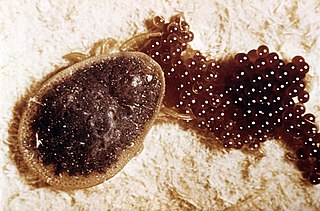 W
WArgas is a genus of tick.
 W
WArgas persicus, also known as fowl tick or poultry tick, is a small soft-bodied tick that is found primarily on domestic fowl such as chickens, ducks, and geese. It was first recorded by Lorenz Oken in 1818 in Mianeh, Persia, and named Rhynochoprion persicum.
 W
WThe Argasidae are the family of soft ticks, one of the two families of ticks. The family contains 193 species, although the composition of the genera is less certain, and more study is needed before the genera can become stable. The currently accepted genera are Antricola, Argas, Nothoaspis, Ornithodoros, and Otobius. The Argasidae are very common in South Asia, along with 96 other species of ticks, making South Asia the region with the highest biodiversity of ticks worldwide. Soft ticks are resistant to desiccation and can live for several years in arid conditions.
 W
WCosmiomma is a genus of ticks first discovered by Paul Schulze in 1919. It is monospecific, being represented by the single species Cosmiomma hippopotamensis. It was first described in 1843 by Henry Denny from specimens collected from a hippopotamus in Southern Africa, and has been called "one of the most unusual, beautiful, and rare tick species known to the world."
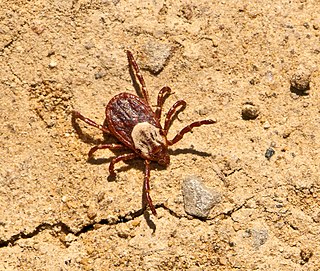 W
WDermacentor is a genus of ticks in the family Ixodidae, the hard ticks. The genus has a cosmopolitan distribution, with native species on all continents except Australia. Most occur in the Nearctic realm.
 W
WDermacentor andersoni, commonly known as the Rocky Mountain wood tick, is a hard tick, or member of the Ixodidae family, with three life stages including larvae, nymph, and finally adult, or, more entomologically, imago. This tick is generally located in the northwest United States and southwest Canada along the Rocky Mountains. This tick is generally a vector for Colorado tick fever, but can also be a vector for Rocky Mountain spotted fever and tularemia. During the larval and nymphal stages, the tick does not feed on humans, but during the adult stage, it will. However, the larvae and nymphs feed on small mammals, including dogs and wildlife. Prevention of infections associated with these ticks is based on control of exposure to the vector, including wearing proper clothing when in woods/wet areas, and checking oneself thoroughly after returning home. Adult female ticks can feed for 5 to 15 days, thus removing a tick if present is very important. Follow general tick removal tips.
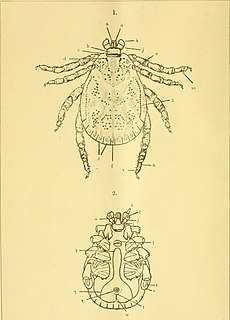 W
WDermacentor auratus is a hard-bodied tick of the genus Dermacentor. It is found in India, Sri Lanka, Indonesia, and Vietnam. The length from capitulum to middle festoon is 7 mm and maximum breadth at its mid length is 5 mm. Adult has highly ornate scutum, capitulum, and legs. A pair of eyes was present at the level of second coxae. Brown base color markings on the dorsal scutum is the characteristic feature.
 W
WDermacentor circumguttatus is a species of hard tick belonging to the family Ixodidae.
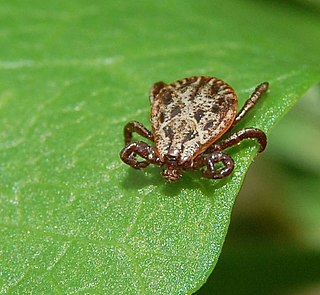 W
WDermacentor reticulatus, also known as the ornate cow tick, ornate dog tick, meadow tick, and marsh tick, is a species of tick from the family Ixodidae. It is the type species for the genus Dermacentor. D. reticulatus is an ornate tick. The female varies in size from 3.8–4.2 mm (unfed) to 10 mm when engorged after feeding. The unfed male is 4.2–4.8 mm long. D. reticulatus is found in Europe and Western Asia, generally in wooded areas.
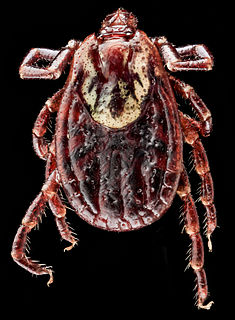 W
WDermacentor variabilis, also known as the American dog tick or wood tick, is a species of tick that is known to carry bacteria responsible for several diseases in humans, including Rocky Mountain spotted fever and tularemia. It is one of the best-known hard ticks. Diseases are spread when it sucks blood from the host. It may take several days for the host to experience symptoms.
 W
WHaemaphysalis is a genus of ticks, containing these species:
 W
WHaemaphysalis concinna is a common rodent tick species that originally predominantly occurred in Russia and Eastern Europe, but is also known from Japan, China, Germany and France.
 W
WThe Yellow Dog Tick,, is a hard-bodied tick of the genus Haemaphysalis. It is also known as African dog tick, or simply as dog tick in many parts of the world.
 W
WHaemaphysalis leporispalustris, the rabbit tick, is a species of tick that is widely distributed in the Americas, stretching from Alaska to Argentina. H. leporispalustris is known to have one of the largest distributions for a tick originating in the New World. It is a three-host tick and a member of the family Ixodidae, commonly called the "hard ticks," and the genus Haemaphysalis. Its common hosts are rabbits, hares, and sometimes ground-feeding birds. H. leporispalustris has a rigid scutum and a prominent capitulum projecting forward from its body and is often said to look like the "wood tick". It has a hemimetabolic life cycle. H. leporispalustris does not play a prominent role in disease transmission in humans but is a vector for disease in other animals.
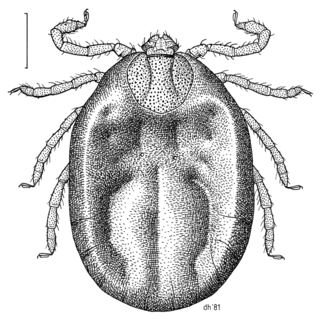 W
WHaemaphysalis longicornis, the Asian longhorned tick, longhorned tick, bush tick, Asian tick, or cattle tick, is a parasitic arachnid belonging to the tick family Ixodidae. The Asian longhorned tick is a known livestock pest, especially in New Zealand, and can transmit a disease called theileriosis to cattle but not to humans. However, the tick has been associated with several other tickborne diseases in humans.
 W
WHaller's organ is a complex sensory organ possessed by ticks. Ticks, being an obligate parasites, must find a host in order to survive; via olfaction and the sensing of humidity, temperature, and carbon dioxide, Haller's organ detects them. Haller's organ is a minute cavity at the terminal segment of the first pair of a tick's legs. Each one is composed of a pit and a capsule, which contain sensory setae.
 W
WHyalomma is a genus of hard-bodied ticks common in Asia, Europe, and North Africa. They are also found in Southern Africa. The name is derived from Greek: hyalos (ὕαλος) crystal, glass; and omma (oμμα) eye.
 W
WHyalomma dromedarii is a species of hard-bodied ticks belonging to the family Ixodidae.
 W
WHyalomma marginatum is a hard-bodied tick found on birds including the pale crag martin. This tick has been implicated in the transmission of Bahig virus, a pathogenic arbovirus previously thought to be transmitted only by mosquitoes.
 W
WIxodes is a genus of hard-bodied ticks. It includes important disease vectors of animals and humans, and some species inject toxins that can cause paralysis. Some ticks in this genus may transmit the pathogenic bacterium Borrelia burgdorferi responsible for causing Lyme disease. Additional organisms that may be transmitted by Ixodes are parasites from the genus Babesia, which cause babesiosis, and bacteria from the related genus Anaplasma, which cause anaplasmosis.
 W
WIxodes angustus is a species of parasitic tick, whose range encompasses the majority of Canada and the United States, along with parts of northern Mexico. I. angustus is a member of the Ixodidae (hard-bodied) family of ticks. It is most abundant in cool, moist biomes such as riparian, boreal or montane zones. I. angustus is a host generalist and has been discovered feeding on more than 90 different host species, including humans and domestic dogs. I. angustus has been identified as a potential vector for Lyme disease but is not considered a principle vector due to the relative rarity with which it feeds on humans.
 W
WIxodes hexagonus, also known by its common name the Hedgehog tick, is a tick species in the genus Ixodes. It is a parasite of the European hedgehog.
 W
WIxodes holocyclus, commonly known as the Australian paralysis tick, is one of about 75 species of Australian tick fauna and is considered the most medically important. It can cause paralysis by injecting neurotoxins into its host. It is usually found in a 20-kilometre wide band following the eastern coastline of Australia. Within this range Ixodes holocyclus is the tick most frequently encountered by humans and their pets. As this area also contains the majority of Australia's most densely populated regions, incidents of bites on people, pets and livestock are relatively common.
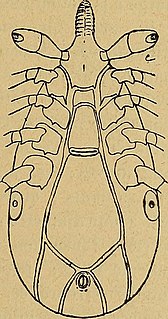 W
WIxodes minor is a species of tick in the genus Ixodes. Some reported hosts are:Cardinalis cardinalis (Georgia) Seiurus noveboracensis (Georgia) Thryothorus ludovicianus (Georgia) Zonotrichia albicollis (Georgia) Troglodytes aedon (Georgia) Oryzomys palustris Peromyscus gossypinus (Georgia)
 W
WIxodes neuquenensis is a species of tick that lives on the monito del monte, a nocturnal marsupial that lives in the temperate forests of southern South America. Due to the near-threatened status of its host, Ixodes neuquenensis is also at risk.
 W
WIxodes pacificus, the western black-legged tick, is a species of parasitic tick found on the western coast of North America. I. pacificus is a member of the Ixodidae (hard-bodied) family. It is the principal vector of Lyme disease in that region. I. pacificus typically feeds on lizards and small mammals therefore its rate of transmission of Lyme disease to humans is around 1% of adults. It is an ectoparasite that attaches itself to the outside of its host and feeds on the hosts blood meal. It can have a heteroxenous lifestyle or monoxenous life cycle depending on how many hosts it feeds on in each cycle. I. pacificus has a four stage life cycle that takes around 3 years to complete. These stages include egg, larva, nymph, and adult. They prefer dense woodland habitats or areas of brush and tall grass.
 W
WIxodes persulcatus, the taiga tick, is a species of hard-bodied tick distributed from Europe through central and northern Asia to the People’s Republic of China and Japan. The sexual dimorphism of the species is marked, the male being much smaller than the female. Hosts include wild and domestic ungulates, man, dog, rabbit, and other small mammals including the dormouse, Amur hedgehog, and occasionally birds.
 W
WIxodes ricinus, the castor bean tick, is a chiefly European species of hard-bodied tick. It may reach a length of 11 mm (0.43 in) when engorged with a blood meal, and can transmit both bacterial and viral pathogens such as the causative agents of Lyme disease and tick-borne encephalitis.
 W
WIxodes scapularis is commonly known as the deer tick or black-legged tick, and in some parts of the US as the bear tick. It is a hard-bodied tick found in the eastern and northern Midwest of the United States as well as in southeastern Canada. It is a vector for several diseases of animals, including humans and is known as the deer tick owing to its habit of parasitizing the white-tailed deer. It is also known to parasitize mice, lizards, migratory birds, etc. especially while the tick is in the larval or nymphal stage.
 W
WIxodes uriae, also known as the seabird tick, is a species of parasitic tick known to infect marine birds. It is native to many high latitude areas in the northern and southern hemispheres including Alaska, Canada, Faroe Islands, Iceland, Greenland, England, Scotland, Norway, Finland, the Kola Peninsula, Russia, Patagonia, South Africa and Australia.
 W
WThe Ixodidae are the family of hard ticks or scale ticks, one of the two big families of ticks, consisting of over 700 species. They are known as 'hard ticks' because they have a scutum or hard shield, which the other big family of ticks, the 'soft ticks' (Argasidae), lack. They are ectoparasites of a wide range of host species, and some are vectors of pathogens that can cause human disease.
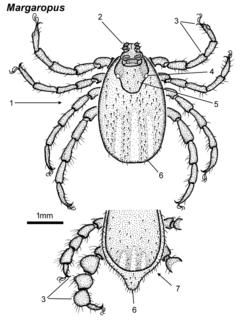 W
WMargaropus is a genus of ticks, characterized as inornate, having eyes, lacking festoons, and with the legs of the male increasing in size from pair I to IV with the segments enlarged, giving them a beaded appearance, from which the genus name was taken, margaritopus signifying beady-legged; the species name memorialized naturalist and entomologist Wilhelm von Winthem.
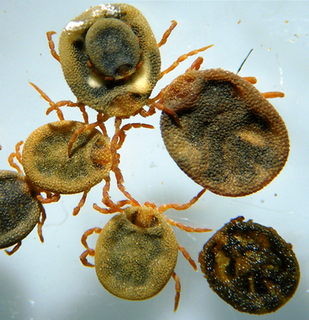 W
WNuttalliella namaqua is a tick found in southern Africa from Tanzania to Namibia and South Africa, which is placed in its own family, Nuttalliellidae. It can be distinguished from ixodid ticks and argasid ticks by a combination of characteristics including the position of the stigmata, lack of setae, strongly corrugated integument, and form of the fenestrated plates. It is the most basal lineage of ticks.
 W
WOrnithodoros is a genus in the soft-bodied tick family, Argasidae.
 W
WOrnithodoros hermsi is a species of soft tick. It can be infected with Borrelia hermsii.
 W
WOrnithodoros kelleyi is an argasid tick parasite of bats found widely throughout North America in caves and other natural and man-made features that harbor bats. The species has not been shown to be a major vector of pathogens.
 W
WOrnithodoros moubata, commonly known as the African hut tampan or the eyeless tampan, is a species of tick in the family Argasidae. It is an ectoparasite and vector of relapsing fever in humans, and African swine fever in pigs.
 W
WOrnithodoros savignyi, known as sand tampan, African eyed tampan or Kalahari sand tampan, is one of some 37 species in the genus Ornithodoros and is a soft tick with a leathery, mammillated integument, causing paralysis and tampan toxicosis, two unrelated conditions. The sand tampan is an ectoparasite on humans, their livestock and wild animals, including birds and bats. Occurring in semi-desert areas of Africa, Saudi Arabia and other parts of the Persian Gulf, India, Sri Lanka and into Asia, it is able to survive for lengthy periods without feeding, spending most of its life burrowed under sand or loose soil, often in wait for animals that rest or sleep under trees or in the lee of rocks, but also in places where people or their animals congregate such as marketplaces, places of worship, cattle kraals and village squares. The timing of its activity is geared to coincide with that of potential hosts, but hot sunny conditions are usually avoided. Because of its habit of feeding and dropping from its host, adult dispersal is limited, whereas larvae may remain attached to their hosts for several days. During its life cycle it will feed on multiple hosts between moults.
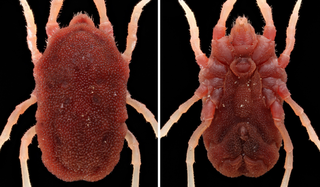 W
WOrnithodoros turicata, commonly referred to as the relapsing fever tick, is a soft tick found in the midwestern and southwestern United States. It is a known vector of Borrelia turicatae, a spirochete responsible for tick-borne relapsing fever in humans. Additionally, vector competence for the transmission of Leptospira pomona, the agent of canine jaundice, has been demonstrated in a laboratory setting.
 W
WOtobius megnini, also known as the spinose ear tick, is a soft-bodied tick that is only parasitic in the larval and nymphal stages. As its common name suggests, the spinose ear tick's parasitic forms are usually found within the ears of the definitive host. This tick has a worldwide distribution, with common hosts that include horses, cattle, sheep, goats, and dogs.
 W
WRhipicephalus is a genus of ticks in the family Ixodidae, the hard ticks, consisting of about 74 or 75 species. Most are native to tropical Africa.
 W
WThe Cattle tick,, is a hard-bodied tick of the genus Rhipicephalus. It is also known as North American cattle tick, North American Texas fever tick, and Texas fever tick.
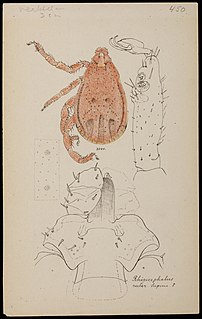 W
WRhipicephalus haemaphysaloides is a hard-bodied tick of the genus Rhipicephalus. It is one of the major medically important ticks in the world.
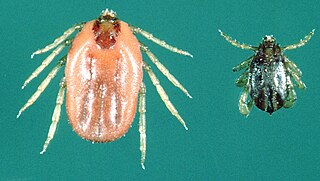 W
WThe Asian blue tick is an economically important tick that parasitises a variety of livestock species. It is known as the Australian cattle tick, southern cattle tick, Cuban tick, Madagascar blue tick, and Porto Rican Texas fever tick.
 W
WThe zebra tick or yellow back tick is a species of hard tick. It is common in the Horn of Africa, with a habitat of the Rift Valley and eastward. It feeds upon a wide variety of species, including livestock, wild mammals, and humans, and can be a vector for various pathogens. The adult male has a distinctive black and ivory ornamentation on its scutum.
 W
WRhipicephalus sanguineus, commonly called the brown dog tick, kennel tick, or pantropical dog tick, is a species of tick found worldwide, but more commonly in warmer climates. This species is unusual among ticks in that its entire lifecycle can be completed indoors. The brown dog tick is easily recognized by its reddish-brown color, elongated body shape, and hexagonal basis capituli. Adults are 2.28 to 3.18 mm in length and 1.11 to 1.68 mm in width. They do not have ornamentation on their backs.
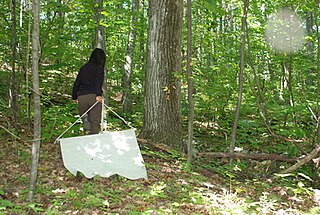 W
WTick dragging is a method for collecting ticks used by parasitologists and other researchers studying tick populations in the wild.
 W
WTicks of domestic animals directly cause poor health and loss of production to their hosts. Ticks also transmit numerous kinds of viruses, bacteria, and protozoa between domestic animals. These microbes cause diseases which can be severely debilitating or fatal to domestic animals, and may also affect humans. Ticks are especially important to domestic animals in tropical and subtropical countries, where the warm climate enables many species to flourish. Also, the large populations of wild animals in warm countries provide a reservoir of ticks and infective microbes that spread to domestic animals. Farmers of livestock animals use many methods to control ticks, and related treatments are used to reduce infestation of companion animals.
 W
WThe U.S. National Tick Collection is the largest collection of ticks in the world. The vital function of the collection is to separate ticks that are medically and financially important from those that are common.